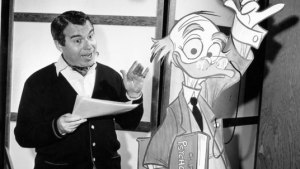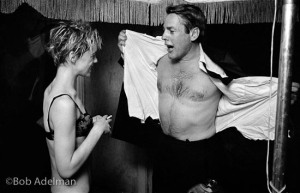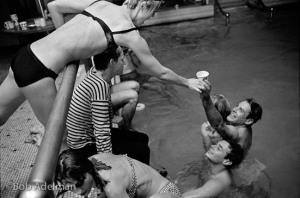I was prepping my lecture on French Impressionist cinema this morning, and thus re-watching La Chute de la Maison Usher. I also got to see a live performance of that same tale last week, so it put me in mind of how many fun “Ushers” there are. I thought I’d share a few with any fellow Poe-heads out there in case one of these slipped past you.
People take a lot of liberties with Poe, so if you don’t know the actual story, you can read it here or better yet let someone with one of the suavest voices ever read it to you —
“The Fall of the House of Usher” read by Basil Rathbone.

In 2000, Caedmon Audio released an amazing audio compilation of Basil Rathbone and Vincent Price reading the tales of Edgar Allan Poe (re-released by Harper Audio in 2012). It’s relatively inexpensive, but it’s also available in lo-fi quality via Spotify for free. If you love Poe, you will treasure these readings.
“The Fall of the House of Usher” (Watson, 1928, approx 13 min.)
This masterpiece of expressionism and American avant-garde was directed and photographed by James Sibley Watson — Western Union heir, Harvard graduate, and medical doctor — from a script by Melville Webber and e. e. cummings. Webber also designed and built the astonishing sets and played “A Traveller” (the narrator in Poe’s version). Watson did the beautiful optical printing.
The National Film Preservation Foundation has some great notes on this one, so I will spare you here, but refer you also to Lisa Cartwright’s essay on Watson and Webber in Lovers of Cinema: The First American Film Avant-Garde, 1919-1945, edited by Jan-Christopher Horak (1995, Univ. of Wisconsin Press).
This is a seriously cool film and really short, so definitely check it out, but make sure you know the story first. No title cards.
Among Watson’s many other achievements, he experimented with motion X-rays in the 1940s. My colleague Miriam Posner writes on this and in passing compares Epstein’s Usher (see below) to Watson’s.
La Chute de la Maison Usher (Epstein, 1928, 78 min.)
This version is a masterpiece of impressionism, and was the first film purchased by the Cinématheque Français. Jean Epstein, like Watson, trained to become a doctor while practicing avant-garde filmmaking on the side. That’s a striking coincidence, if you ask me: two med students, two Ushers, same year. For more on Epstein (he was quite the character), see the Silent Film Festival’s notes. He wrote plenty of theoretical essays himself too, if you’re so inclined.
The script is by none other than Louis Buñuel, fresh off of “Un Chien Andalou.” Marguerite Gance, wife of master filmmaker Abel Gance, stars as Madeleine, and Jean Debucourt — an actual actor, best remembered in the US for Ophuls’ The Earrings of Madame de… 1953 — is a stoic and moving Roderick.
Impressionist films feature more diffuse light and shadow than the expressionist style, which gives them a softer, dreamy quality. Whereas the Watson & Webber’s version is darkly creepy, Epstein’s is eerily haunting. High contrast, negative imagery, and thoughtful composition make even location shots in daylight discomforting.
The story was changed — by script-writer Buñuel? — so that Madeleine is Roderick’s wife. I find that surprising given that Buñuel did not shy away from irreverence, but then again, this was Catholic France, maybe incest was going too far.
I admit the deliberately slow pace of this film is hard for contemporary sensibilities. Watch it on as large a screen as you can — if you can get a dvd version, do — lights out, sipping brandy or port.
House of Usher (Roger Corman, 1960, 79 min.)
American International (AIP) in CinemaScope [how I love that 2.35:1 aspect ratio!], starring (my hero) Vincent Price as Roderick, Myrna Fahey as Madeline, and Mark Damon as the visitor — her fiancé in this version. I guess it was deemed more attractive to the teen audience to have defiant young lovers at the center rather than male friendship. The script is by Richard Matheson of Twilight Zone, I am Legend, and Duel fame amongst many others.
This one is a little tame in comparison with the later Corman-Price collaborations; it might be because “personable” Mark Damon (also known for Black Sabbath [Bava, 1963] gets the lion’s share of the screen time, and he’s kinda zzzz.
There are some great moments though. Particularly gorgeous is the scene in which Price recounts the Usher family’s history. It begins “outside” with mesmerizing tracking across a foggy soundstage of trees. As he talks without interruption, a cut reveals they have moved into the portrait gallery. And a rogue’s gallery it is. The Ushers as imagined by Corman and Matheson are more Borgia than Poe described.
Did I mention the Director of Photography was Floyd Crosby who also photographed Tabu (Murnau, 1931), High Noon (Zinnemann, 1952), Oklahoma (Zinnemann, 1955), The Old Man and the Sea (Sturges, 1958)? He shot that last one after a string of AIP gems such as Attack of the Crab Monsters (Corman, 1957), Reform School Girls (Edward Bernds, 1957) and The Screaming Skull (Alex Nicol, 1958) just to name a few. Apparently he loved working on B films. Also you might also have heard of his son, David. For more on Crosby senior, see Wheeler Winston Dixon’s blog.
Wicked Lit
Last week I attended Wicked Lit at the Mountainview Mausoleum in Altadena, CA. I know, it’s not cinema but it’s tangentially related. Wicked Lit is a live theater group in the L.A. area that does site-specific immersive theater. Their annual three-play event is a Halloween must. This year the plays are The Fall of the House of Usher, The Ebony Frame, and The Grove of Rashomon. Yes, that Rashomon — I told you it was cinema-related — here it is a ghost story rather than a trial story, though I did remind my accompanying friends that Kurosawa’s Rashomon features one ghost as well (at minute 50).
All three were great, though I particularly enjoyed Usher which was staged entirely in the mausoleum, and during my visit, featured unscripted appearances by resident bats!! Believe me you haven’t lived until you’ve been chasing Roderick Usher down a dimly-lit, crypt-lined hall as bats zoomed past just above your head. Very fun! Go see!
Finally A Couple of Radio Dramatizations of Interest…

CBS Escape (1947) – Voice actor extraordinaire, Paul Frees (Haunted Mansion, Boris Badenoff, John Lennon), as the Narrator, with score by legendary Cy Feuer, right after having left Republic Pictures. Must be how he met Ernest H. Martin, head of CBS radio programming, with whom he would become the dynamic producing duo of Broadway musicals (Guys and Dolls, How to Succeed in Business, etc.). [Bonus Haunted Mansion outtakes]
CBS Radio Mystery Theater (1974) starring an intense Kevin McCarthy (Invasion of the Body Snatchers).


Another time travel destination added to my list!
